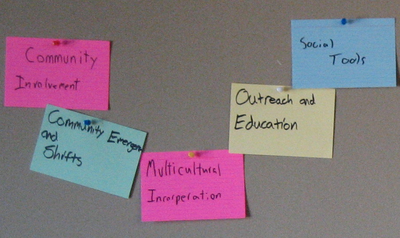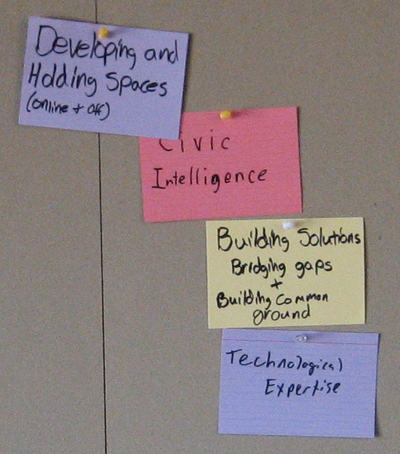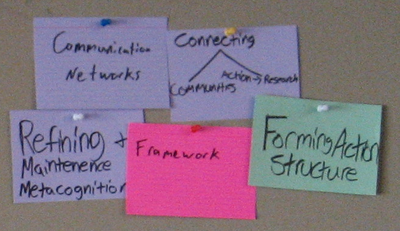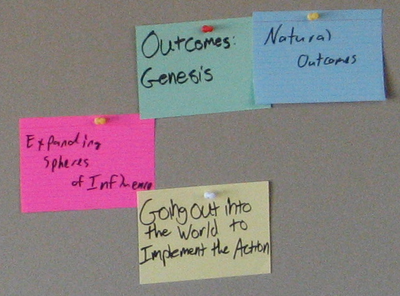CIRAL Components
Contents
- 1 Learning Objectives
- 2 Core Class Contents
- 3 Course Topics
- 4 Course Projects
- 4.1 Local Economy
- 4.2 Social Action: Presence and Voice
- 4.3 Producing a good or a service
- 4.4 Community Building/Life Enriching Event
- 4.5 Crowdsourcing information for civic ends
- 4.6 Organizational Accountability
- 4.7 Public Mental Health Care
- 4.8 Non-zero sum game workshop
- 4.9 Mycorestoration action team with Education and Spawn Bank
- 4.10 Public Space Clean Up
- 4.11 Free School Project
- 4.12 Interactive Wiki Training Game (Galen, ?, ?)
- 4.13 Revamping Shelters
- 4.14 Projects from Workshop
- 4.15 Evergreen Student Organization
- 5 Research
- 6 Action
- 7 Think Tank / Ongoing Research and Other Work in "Home Office"
- 8 Administering CIRAL
Learning Objectives
The following learning objectives are from the Patterns of Intelligence program (Fall 2011). They may or may not be relevant. And — probably — they'd need to be augmented when strongly coupled with community work.
The program has 12 learning objectives. Obviously, not all of these objectives will receive the same emphasis in the program. Equally important, each student will find some objectives more important and interesting than others. For these reasons I encourage every student to consider these objectives in relation to their own goals, interests, learning styles, etc. As you consider the objectives, remember that the most important or interesting objectives may not be the easiest to achieve for you or for the class overall. Finally, a thorough understanding of program objectives will help both students and faculty in the evaluation process. The student's self-evaluation of progress and the faculty evaluation of student progress should both be based on the learning objectives to a large degree.
1. Program Themes. To gain a better understanding of major program themes including intelligence, collective intelligence, and civic intelligence — and their relation to various sectors and components of society
2. Understanding of Context. To gain a better understanding of underlying social, technological, and other circumstances that affect the spectrum of possibilities for understanding and addressing challenges
3. Processes of Social Change. To gain increased knowledge of how social change takes place
4. Understanding of Challenges. To gain an increased understanding of the particular challenges of our era and the mechanisms that are now governing it
5. Risks and Responsibilities. To gain a better understanding of the risks and responsibilities of civic engagement and civic intelligence
6. Speak the Language. To gain a better understanding of pertinent lexicon, theories, issues, ideas, and data
7. Skills, Tools, and Processes. To gain a better awareness, appreciation, and proficiency with communication approaches and other skills, tools, and processes available to the public that can influence social directions as well as learning about the barriers to participation
8. Tools and Frameworks. To gain increased knowledge of useful analytic tools and frameworks
9. Foundation for Future Work. To build a foundation for future paid or unpaid professional, avocational, community, or activist work
10. Foundation for Future Inquiry. To build a foundation for pursuing the questions we didn't answer after the program ends
11. Active Role in Personal and Community Education. To improve your own approach to learning, to do what you can to ensure that your educational needs are met, and to help improve the educational environment around you, for you and for others.
12. Personal Power and Social Imagination. To gain a better sense of one's own power and social imagination for the future. To learn how to catalyze change; to speak the truth even if your voice shakes
Core Class Contents
- Teaches basics of understanding ideas in a group context
- Enables people on different contracts/projects to communicate, share ideas, compare and enhance their own projects
- Has a manual designed to help students ask the right questions, especially in terms of coordinating group planning. (Tasks For Planners)
- Provides space for ideas to have pollenate, or at least resembles Steven Johnson's idea of a coffee house, where students will "identify environments that stimulate networks of ideas/insight," and where this "liquid network of ideas and experiences lead to innovation" and hopefully the "slow hunch." ("Where Good Ideas Come From (Ted Talk)).
- Creates an environment where ideas can spread as potent memes to pragmatically deal with and confront real world issues.
What do we do summer quarter??
Activity Grants to help cover lack of Financial Aid?
Course Topics
Brainstorm topics that should (or could) be covered in the core class. (Tasks For Everyone)
Please add to this list (Tasks For Everyone)
- Budgeting
- Cybernetics
- Cultural Transition
- Epistemology
- Ethnography
- Facilitation skills
- Grant Writing
- Information Science
- Intelligence -- Individual, Collective and Civic
- Models of Non-profit Organizations
- Motivational Speaking
- Non-Violent Communication
- Ontology
- Planning and Management
- Social Change -- Theory and Practice
- Sociology
- Trust (in ones' self and community)
- Writing Evergreen Learning Contracts
- Visual Presentation Abilities
Core Curriculum
I thought there should be a page to keep the 'final' product that can be linked to from each model and elsewhere.
Course Projects
A large portion of CIRAL is to provide continuity to ongoing research and action projects. The following proposals will not necessarily be offered as a part of the Lab. These explorations of possible projects will help us develop a sense of what goes into developing a project that could take place in the context of CIRAL.
Things to keep in mind while fleshing these project ideas out:
- Community Partners - who will the project work with
- Resources - is it something that will need a funding source, or faculty support
- Scale - what size of student team is needed to accomplish the project
- Scope - how long will the project go on
- Development - is there limited scope or could the project develop into a standing partnership that does a specific thing in the community
Local Economy
- Alternative Currencies
- Community Asset Mapping
- Time-banking
- Barter Events
- DIY Workshops
Social Action: Presence and Voice
Producing a good or a service
Examples:
- Growing food
- Cleaning water
- Building machines
- Creating a space for community to come learn and teach
Community Building/Life Enriching Event
Hosting an event that will either strengthen the community or enrich peoples' lives.
Examples:
- Secret Cafe
- Non-zero sum game nights
- Workshops
Crowdsourcing information for civic ends
Scientific research through smart phones, imagery analysis during natural disasters.
Organizational Accountability
Researching an organization through publically available information, as well as investigating private details.
Public Mental Health Care
Creating a (radical) local mental health solution that connects people with neural diversity/mad gifts with resources that they need. Depathologize mental illness, as well as mental health symptoms that we all face as everyday life issues, by providing alternative literature/audio for self-care.
Non-zero sum game workshop
Simulation of how life is a non-zero sum game, and making the connection through activities that use a proxy as the platform of discussion.
Mycorestoration action team with Education and Spawn Bank
Public Space Clean Up
Free School Project
Interactive Wiki Training Game (Galen, ?, ?)
Revamping Shelters
Working with several communities and companies to pull resources, especially in this time of hardship, to help youth, minorities, battered men and women the displaced. Provide better opportunities to learn trades/skills and the resources for education.
Projects from Workshop
We were addressing a foundation for how a class could start out and progress long term, and what types of actions and research they would be doing along the way.
Evergreen Student Organization
- Agricultural/Environmental Groups:
- Community Gardens
- Barrier Breakers: Enabling people with different abilities, to obtain physical, technological, environmental and especially educational access throughout The Evergreen State College communities.
- Clean Energy Committee Clean Energy Committee: strives to promote clean energy technology by providing financial support for green energy projects that benefit the college, the local community, and the global environment
- Social Justice/Human Rights Groups:
- Amnesty International
- Black student union: The purpose of the Black Student Union (BSU) is to provide unity amongst those who identify with Black Peoples, while engaging the Evergreen community through cultural, educational, and entertaining activities.
- Committee in Solidarity with the People of El Salvador (CISPES)
- Latin American Solidarity Organization: Focus on immigration rights and social justice.
- Mideast Solidarity Project
- Students of Democratic Society: They fight against all forms of oppression and class division. We seek to bridge the Olympia-Evergreen gap.
- YAYA: The Youth and Young Adult Network of National Farm worker Ministry (NFWM), an inter faith organization that supports farm workers as they organize for empowerment, justice and equality.
- Evergreen Queer Alliance: The EQA aims to serve the needs of the queer community at the Evergreen State College by providing a safe space, resources, advocacy, awareness, education, entertainment, and community
- Woman of color
- Women’s resource center
- Transgender Resource and education
Pattern Card Workshop The following photos probably don't belong here!
Please correct project themes if this is inaccurate. (Tasks For Everyone)
Research
Here's our summary from Saturday's workshop. Can other folks in the research group add to this? It doesn't seem to be a very complete recollection of our insights. (Tasks For Everyone)
The first step for our research component is to build a framework for exploration. As we begin data gathering we will need to develop tools for parsing that information. Specific research projects will develop out of interest of participants and better understanding of the group's capability. The scope of research will broaden from local inquiry to international as the project develops.
Action
We started out with a divided and randomized set of cards.
We individually determined which ones would be applicable to the actions of CIRAL short, medium, and long term.
We then laid out the cards on our own, according to priority (top) and timing of action (left early, right later)
Perceptions of how to divide the cards into sections included:
- One action card to represent the action to take
- More than one action card to specify certain tasks
- One themed card group represenation per section
- More than one themed card group per section
- Dividing of cards into multiple sections with variable priorities (i.e. placing card on the boarder of 2 or 4 sections).
Because we only had one of each card, we were limited in our visual representation of where we could have certain cards be representative. It possibly moved us to put things that we believe in having throughout at the beginning, and didn't allow anything else to jeoparadize the chance for it to be present on the left.
Cards were stacked within the sections so that the name would show.
We picked cards up to re-read the text, considering where we might re-locate the card. Consideration for where the card was and where someone would put it may or may not have weighed in for everyone. Individuals solicited placement and meaning of certain cards from the whole group.
Brandon was impacting the layout by moving cards into redundancy groups (i.e. themes), concerned that there was too much going on with some sections to really get a sense of what a section was specifying to do. Brandon and others were also attempting to remove topics that were considered a redundancy to a group of cards (e.g. several media sources with the option to remove certain kinds of media).
For having a shared vision, committment, and hand in the direction.
1) CIRAL is a paritcipatory design, with a shared vision, designed for unintended used. That uses community networking to establish a public agenda through appreciative collaboration. Forming the action structure.
2) Different ways of design and strategy for your collective effort. Refining the action structure.
3) Going out into the world and neighboring communities to create change. Implementing the action.
4) Developing spaces and skills (the actual places that you hold space).
5) Outreach into knowledge of the public. Establishing a non-physical present through press and online presence.
6) Shift into being a cohesive larger collective that doesn't exclude people by difference. Moving into the larger community, or bringing the larger community in (university into the masses).
7) Leveraging technology to connect with global communities to see what they are trying.
8) Sharing with global communities to create value and provide solutions to human needs. Connection action to research.
9) Continuing on to the next level of change (genesis).
After deciding on the themes, we wrote each onto an index card and put them on a wall with the research group's index cards.
Both groups combined cards together by how related they are.
After having approximately 4 groups of index cards, we decided to break up into three groups by counting off by 3. We were tasked with creating a project that would achieve the concepts on the index cards.
We came up with a multicultural project, a free school project, and a technology learning project.
Think Tank / Ongoing Research and Other Work in "Home Office"
"Home Office" / "Think Tank"
In addition to preparing people to go into the field (which includes cultural competency, skill-building, etc.), the following research and related activities could be undertaken as part of the research work in what we might call the "home office" or "think-tank". Although these activities are specifically listed in relation to Evergreen's Gateways project, that supports education for incarcerated youth at Green Hill, they are generally applicable to other projects as well.
- Policy research and development work
- PSA & other public awareness work
- Research on economic impacts of incarceration (now about 60 - 70 billion dollars direct expenses yearly in US)
- Institutional memory of the project
- Curricular development or other training and educational programs for Gateway and Evergreen community members
- Educational philosophy of the project and Evergreen's support
- Institutionalization of the project, in general and at Evergreen
- Exporting model (to other schools and other regions)
- Researching other relevant approaches (in other regions, countries, departments, etc.)
- Placement in jobs, education
- Surveys and other approaches to understanding the problem and evaluation
- Technical support to project, e.g. logistics, computer, administration, planning, facilitating design
- Mapping and community studies (e.g. of places students come from)
- Understanding problem domain, history, economic and political contexts,
- Maintain relevant reference (etc.) library or other resource
- Identifying resources and securing them
- Facilitating conversations, conferences, working sessions, etc. about the problem and possible solutions
Administering CIRAL
What are the processes that we need to consider? E.g. How might we develop, maintain, and, possibly, disengage from a community partnership? I.e. is a "partnership" different from just sending an intern or two out?
How would we describe various "life-cycles?" (And where might we go to find out more about this?)
What documents might we sign? Is there a covenant, for example?




